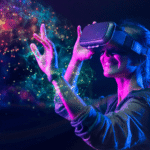Spatial computing—the seamless blend of augmented reality (AR), virtual reality (VR), and mixed reality (MR)—is poised to transform how we interact with technology. By 2025, the spatial computing market is projected to reach $280 billion, reshaping industries from healthcare and retail to manufacturing and entertainment.
This in-depth guide explores how spatial computing is evolving beyond headsets into everyday life, the key players driving innovation, and the future of immersive digital experiences.
1. What Is Spatial Computing?
A. Beyond AR and VR: A Unified Ecosystem
Spatial computing merges:
- AR (Augmented Reality): Digital overlays on the real world (e.g., Snapchat filters, Pokémon GO)
- VR (Virtual Reality): Fully immersive digital environments (e.g., Meta Quest, PlayStation VR)
- MR (Mixed Reality): Interactive blending of real and virtual worlds (e.g., Microsoft HoloLens)
B. Core Technologies Powering Spatial Computing
| Technology | Role | Example |
|---|---|---|
| LiDAR Scanning | Maps physical environments | Apple Vision Pro |
| Neural Interfaces | Brainwave-controlled VR | Neuralink (in development) |
| Haptic Feedback | Simulates touch sensations | Meta’s haptic gloves |
2. How Spatial Computing Is Changing Industries (2025 Outlook)
A. Retail & E-Commerce
- Virtual try-ons: 40% of Gen Z shoppers use AR before purchasing (Snapchat)
- AI-powered store navigation: Walmart testing AR aisle guides
B. Healthcare
- Surgical precision: Surgeons practice in 3D holographic simulations
- Mental health therapy: VR exposure therapy for PTSD shows 75% success rate
C. Manufacturing & Training
- Remote expert assistance: AR overlays guide technicians in real time
- VR safety training: Reduces workplace injuries by 45% (PwC study)
D. Entertainment & Social Media
- Meta’s Horizon Worlds: Persistent VR social spaces
- AI-generated virtual concerts: Travis Scott’s Fortnite event drew 27M viewers
3. The Future of Human-Computer Interaction
A. The Decline of Screens
- Smart glasses replacing smartphones: Apple, Meta, and Google investing billions
- Gesture & voice controls: No more keyboards or touchscreens
B. AI + Spatial Computing = Hyper-Personalization
- Context-aware AR ads: Digital billboards adapt to your interests
- AI virtual assistants in VR: ChatGPT-powered avatars
C. The Metaverse Becomes Reality
- Digital twins of cities: Singapore’s Virtual Singapore project
- Virtual workplaces: Microsoft Mesh for 3D remote meetings
4. Challenges & Barriers to Adoption
A. Hardware Limitations
- Battery life: Current AR glasses last <4 hours
- Motion sickness: 30% of users experience VR discomfort
B. Privacy Concerns
- Always-on cameras: Potential for surveillance misuse
- Biometric data collection: Who owns your VR behavior patterns?
C. High Costs
- Apple Vision Pro: $3,499 limits mass adoption
- Enterprise VR setups: $10K+ per station
5. Key Players to Watch in 2025
| Company | Focus Area | Product |
|---|---|---|
| Apple | Consumer AR/VR | Vision Pro |
| Meta | Social VR | Quest 3 |
| Microsoft | Enterprise MR | HoloLens 3 |
| NVIDIA | AI + 3D rendering | Omniverse |
6. How Businesses Can Prepare
A. Experiment with Pilot Programs
- AR for employee training
- VR product demos
B. Upskill Teams in 3D Design & AI
- Unity/Unreal Engine developers in high demand
- Prompt engineering for VR
C. Monitor Regulatory Changes
- EU’s AI Act affecting VR data collection
- FTC guidelines on AR advertising
Conclusion: The Spatial Computing Era Has Begun
By 2025, expect:
✅ Smart glasses replacing smartphones
✅ AI-powered virtual assistants in AR
✅ VR workspaces becoming standard


